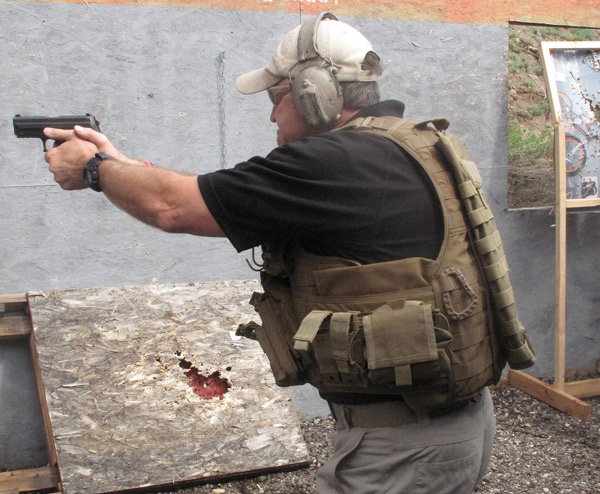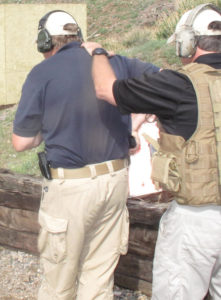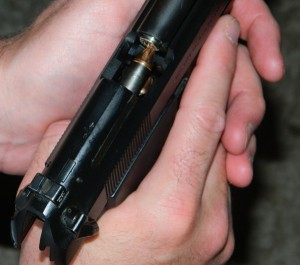

SWAT teams, Special Forces groups and other operators are constantly training when not on a mission or active call. Civilian shooters should obtain this same mindset when it comes to self-defense training. Here are three skill sets with shooting drills that are certain to improve a shooter's capabilities when it matters most.
Failure Drill
Also known as the Mozambique drill, the failure drill was designed as a way to stop advancing threats when body shots weren’t enough. Mike Rousseau first used the method during the Mozambican War of Independence. Armed with a Browning Hi-Power, Rousseau encountered an assailant armed with an AK-47 and put two rounds into the attacker’s body. When the attacker continued to advance, Rousseau aimed at the head and put the man down.
Drill:
- Set a silhouette target at seven yards (21 feet) and from either a low-ready position or holstered position, fire two fast shots into the center mass of the target. Then, assess the situation, determine the attacker is still advancing and fire a carefully placed shot at the head. Variations can be added by including lateral movement, or by firing from cover or the ground. The possibilities are only limited by imagination and the potential ways from which a shooter might need to fire.
Pressure Drills
The hardest factor to train for in a self-defense situation is pressure. During a life and death struggle a person’s heart rate rises, breathing becomes erratic and fine motor skills break down. This is why firearm instructors stress motor skills in shooting drills, as well as repetition to ensure that needed handgun skills. A person must be able to perform these actions when the body is in flight-or-fight mode. One way to bring out a level of stress on the range is by elevating heart rate and breathing through exercise.

Drills:
- Shooters should perform push-ups, sit-ups or side-straddle hops, or sprint a set distance and back to increase heart rate and breathing before each shooting scenario. Shooters can also include a stopwatch to compete against a partner or try to beat their own times to increase the pressure.
- Shooters might opt to implement exercise into a shooting scenarios. A three-stage scenario works well, with targets set up 40 yards apart. Start at position one, draw and fire two rounds before sprinting to position two and on to position three and back to the beginning. Variations can be implemented by adding magazine changes, setting up barriers for shooting from cover and rotating station numbers. Use a stopwatch to produce competitive results against friends that will show progress.
Malfunction Drills
Whether it’s an empty chamber, a stovepipe or a double feed, a handgun malfunction at a critical time is more than just a problem; it can get a person killed. That’s why shooters should always perform proper maintenance on firearms, but most especially on carry guns. The handgun that is carried daily should be broken in to handle all types of ammunition, cleaned and lubricated after every shooting session and inspected regularly to ensure no foreign objects have worked down into the mechanism during carry. Magazines should also be rotated to maintain spring pressure, as magazines are one of the leading causes of semi-auto handgun malfunctions.
- The Tap & Rack, it should be conducted if a semi-auto handgun fails to fire, as it will fix most malfunctions. The Tap & Rack consists of a hard tap on the bottom of the magazine along with a hard rack of the slide. This procedure returns a gun back to the ready condition for unseated magazines and failure to eject malfunctions.
- Clearing double feeds malfunctions. If the Tap & Rack doesn’t work, drop the magazine and cycle the slide at least two times. Then, reinsert the magazine and rack the slide. If these two procedures fail to clear the handgun, then it is most likely jammed and will require tools for proper repair.
- The last drill requires a partner who creates a malfunction and hands the gun to the shooter without revealing the type of malfunction. The shooter takes the gun, aims at a target and pulls the trigger. When the gun fails to fire, the shooter must assess the situation, clear the firearm and finish the scenario with two rounds in center mass on the target. Variations include not causing a malfunction, loading only one round to force a reload and inserting an empty magazine. The only constant is that the shooter should not know the condition of the gun during the situation.
Firearm skills are finite and need to be constantly renewed to ensure proper use. Drills help maintain muscle memory, but must be performed regularly or the skills will not be there when they are needed.
Editor's Note: This article appeared in the November 18, 2013 edition of Gun Digest the Magazine.

Next Step: Get your FREE Printable Target Pack
Enhance your shooting precision with our 62 MOA Targets, perfect for rifles and handguns. Crafted in collaboration with Storm Tactical for accuracy and versatility.
Subscribe to the Gun Digest email newsletter and get your downloadable target pack sent straight to your inbox. Stay updated with the latest firearms info in the industry.


![Best Concealed Carry Guns In 2025 [Field Tested] Wilson Combat EDC X9S 1](https://gundigest.com/wp-content/uploads/Wilson-Combat-EDC-X9S-1-324x160.jpg)


![Best 9mm Carbine: Affordable PCCs [Tested] Ruger Carbine Shooting](https://gundigest.com/wp-content/uploads/Ruger-Carbine-Shooting-100x70.jpg)
![Best AR-15: Top Options Available Today [Field Tested] Harrington and Richardson PSA XM177E2 feature](https://gundigest.com/wp-content/uploads/Harrington-and-Richardson-PSA-XM177E2-feature-100x70.jpg)
